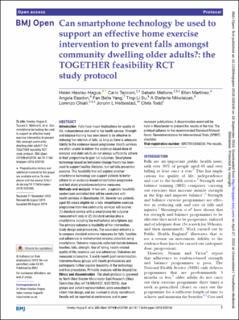| dc.contributor.author | Hawley-Hague, Helen | |
| dc.contributor.author | Tacconi, Carlo | |
| dc.contributor.author | Mellone, Sabato | |
| dc.contributor.author | Martinez, Ellen | |
| dc.contributor.author | Easdon, Angela | |
| dc.contributor.author | Yang, Fan Bella | |
| dc.contributor.author | Su, Ting-Li | |
| dc.contributor.author | Stefanie Mikolaizak, A | |
| dc.contributor.author | Chiari, Lorenzo | |
| dc.contributor.author | Helbostad, Jorunn L. | |
| dc.contributor.author | Todd, Chris | |
| dc.date.accessioned | 2022-05-03T08:49:24Z | |
| dc.date.available | 2022-05-03T08:49:24Z | |
| dc.date.created | 2020-03-24T15:56:36Z | |
| dc.date.issued | 2019 | |
| dc.identifier.citation | BMJ Open. 2019, 9 (9), 1-11. | en_US |
| dc.identifier.issn | 2044-6055 | |
| dc.identifier.uri | https://hdl.handle.net/11250/2993794 | |
| dc.description.abstract | Introduction Falls have major implications for quality of life, independence and cost to the health service. Strength and balance training has been found to be effective in reducing the rate/risk of falls, as long as there is adequate fidelity to the evidence-based programme. Health services are often unable to deliver the evidence-based dose of exercise and older adults do not always sufficiently adhere to their programme to gain full outcomes. Smartphone technology based on behaviour-change theory has been used to support healthy lifestyles, but not falls prevention exercise. This feasibility trial will explore whether smartphone technology can support patients to better adhere to an evidence-based rehabilitation programme and test study procedures/outcome measures.
Methods and analysis A two-arm, pragmatic feasibility randomised controlled trial will be conducted with health services in Manchester, UK. Seventy-two patients aged 50+years eligible for a falls rehabilitation exercise programme from two community services will receive: (1) standard service with a smartphone for outcome measurement only or (2) standard service plus a smartphone including the motivational smartphone app. The primary outcome is feasibility of the intervention, study design and procedures. The secondary outcome is to compare standard outcome measures for falls, function and adherence to instrumented versions collected using smartphone. Outcome measures collected include balance, function, falls, strength, fear of falling, health-related quality of life, resource use and adherence. Outcomes are measured at baseline, 3 and 6-month post-randomisation. Interviews/focus groups with health professionals and participants further explore feasibility of the technology and trial procedures. Primarily analyses will be descriptive.
Ethics and dissemination The study protocol is approved by North West Greater Manchester East Research Ethics Committee (Rec ref:18/NW/0457, 9/07/2018). User groups and patient representatives were consulted to inform trial design, and are involved in study recruitment. Results will be reported at conferences and in peer-reviewed publications. A dissemination event will be held in Manchester to present the results of the trial. The protocol adheres to the recommended Standard Protocol Items: Recommendations for Interventional Trials (SPIRIT) checklist. | en_US |
| dc.language.iso | eng | en_US |
| dc.publisher | BMJ Publishing Group | en_US |
| dc.rights | Navngivelse 4.0 Internasjonal | * |
| dc.rights.uri | http://creativecommons.org/licenses/by/4.0/deed.no | * |
| dc.title | Can smartphone technology be used to support an effective home exercise intervention to prevent falls amongst community dwelling older adults?: the TOGETHER feasibility RCT study protocol | en_US |
| dc.title.alternative | Can smartphone technology be used to support an effective home exercise intervention to prevent falls amongst community dwelling older adults?: the TOGETHER feasibility RCT study protocol | en_US |
| dc.type | Peer reviewed | en_US |
| dc.type | Journal article | en_US |
| dc.description.version | publishedVersion | en_US |
| dc.source.pagenumber | 1-11 | en_US |
| dc.source.volume | 9 | en_US |
| dc.source.journal | BMJ Open | en_US |
| dc.source.issue | 9 | en_US |
| dc.identifier.doi | 10.1136/bmjopen-2018-028100 | |
| dc.identifier.cristin | 1803321 | |
| cristin.ispublished | true | |
| cristin.fulltext | original | |
| cristin.qualitycode | 1 | |

